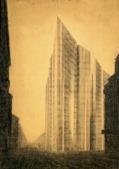tower - In
architecture, a tall, vertical structure
that either stands free or is part of a building.
Among the various kinds of towers are belfries, campaniles,
keeps, barbicans, minarets,
obelisk, pagoda,
pinnacle, sikhara,
skyscrapers, steeples, turrets,
and watchtowers.
Examples:
Alexandria, Egypt, The Pharos Lighthouse, 3rd century, BCE, height c. 500 feet, constructed in three sections, the lowest part was square in plan, built of marble blocks with lead mortar, enclosing a helical ramp that permited carts to bring materials to the top in horse-drawn carts. The center part was a tower octagonal in plan, on which the uppermost part -- a cylinder -- was surmounted by an open cupola in which the fire burned to provide the light. A large curved mirror, probably made of polished metal, was used to project the fire's light into a beam. A staircase and dumbwater led from the first part up to the cupola; and atop the cupola, stood a statue of Poseidon, god of the sea. The city of Alexandria had been founded by the Macedonian conqueror Alexander the Great in 332 BCE, and was completed by his son Ptolemy Soter. In 290 BCE, needing a symbol of greatness for its bustling harbor, Ptolemy authorized Sostrates of Knidos to design a tower from which a bright light would shine on the island of Pharos. When it was completed twenty years later, it was the first lighthouse in the world and, with the exception of the Great Pyramid, the tallest building in existence. Considered one of "The Seven Wonders of the Ancient World," the Pharos Lighthouse stood for about 1500 years, but was damaged and ruined by earthquakes in 365 CE and 1303, falling completely in 1326.

Pakistan, ancient region of Gandhära,
Model of a stupa (Buddhist shrine), c.
4th century CE,
bronze, height 22 3/4 inches (57.8
cm), width 7 1/2 inches (19.1
cm), Metropolitan Museum of Art, NY. See Buddhist art and model.
Rheims Cathedral, 1211-1290, was the coronation church of the kings of France. The western façade, designed by the architect Bernard de Soissons, has the usual recessed portals carved with about 500 statues; the tympana are occupied by rose windows instead of sculpture, and each is framed in by five rings of statues and enclosed by ornamented gables, of which the central one contains the group of the Coronation of the Virgin. Above the central portal is the rose window (diameter 40 feet), flanked by high traceried openings; while in the upper stage is a band of tabernacled statues of the kings of France, above which rise two towers (1305-1427, height 267 feet) with angle turrets and incompete spires. See cathedral.

Shah Jahan (Indian, Mughal emperor who reigned
1627-1658), Taj Mahal, 1630-1653, an Islamic tomb
in a walled garden built for Shah Jahan's wife Mumatz Mahal,
of bearing masonry and
inlaid marble, with onion-shape domes
and flanking towers, in Agra, India, seat of the Mughal Empire.
Sir Banister Fletcher wrote in A History of Architecture, "The interior of the building is dimly lit through pierced
marble lattices and contains
a virtuoso display of carved
marble. Externally the building
gains an ethereal quality from its marble facings, which respond with extraordinary subtlety
to changing light and weather." See Mughal
dynasty.

Gustave Eiffel (French, 1832-1923) , Eiffel Tower, 1887 - 1889, exposition
observation tower, exposed iron
construction, height 985 feet, a symbol
of Paris worldwide. Built for Paris's 1889 International Exhibition,
the centenary celebration of the French Revolution. It is the
subject of several paintings by Robert Delaunay (French,
1885-1941), including The Eiffel Tower, 1926, oil
on canvas, 169 x 86 cm,
Centre Georges Pompidou, Paris. See Orphism.
Frank Lloyd Wright (American, 1867-1959), Frank Lloyd Wright Spire, designed in 1957, built in 2004, Scottsdale, AZ. Wright originally designed this tower for the Arizona State Capitol, but the project was not built. The developer of an office park in the town where Mr. Wright spent many working winters has built the tower according to the original plans, at the intersection of two prominent streets, one of which is named Frank Lloyd Wright Boulevard. The spire weighs more than 75,000 punds, assembled with approximately 1,700 individual pieces of steel. An internal illumination system includes 142 eight-foot lamps that range in size from 30 to 96 inches.

Simon Rodia (born Sabato Rodia) (American,
born Italy, 1879-1965), Nuestra Pueblo (The Watts Towers), c.
1921 - 1954, steel
rebars, wire mesh, cement,
and shards of tile
and pottery (pique
assiette), found glass bottles,
seashells, etc.; highest tower's height
99 feet, Watts district of Los Angeles, 1765 East 107th Street.

Ludwig Mies van der Rohe (German, 1886-1969),
Friedrichstrasse Skyscraper, Berlin-Mitte, Germany,
a project in 1921, this is a perspective
drawing
from the north, charcoal
and pencil on tracing
paper mounted
on board, 68 1/4 x 48 inches (173.4 x 121.9 cm), Museum of Modern
Art, NY. This design
for a twenty-storey tower was based on the untried idea that
a supporting steel
skeleton would be able to free the exterior walls from their
load-bearing function,
allowing a building to have a surface
that is more translucent
than solid.
Also see architecture, column, crown, finial, harmika, pillar, and yasti.
https://inform.quest/_art